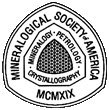 |
The Mineral Identification Key |  |
 |
The Mineral Identification Key |  |
Table IIC-2b: Nonmetallic Luster; Streak Not Colored; Hardness 2½ to 3; Cleavage Not Prominent; Infusible in a Candle Flame. [Previous Table] [Next Table]
| Color | Hardness | Luster | Name | System | Habit | SG | Notes |
| White to Tan, may be Greyish | 2 to 2½ | Earthy | KAOLINITE Al2Si2O5(OH)4 |
Triclinic | Usually as compact earthy masses | 2.6 | Has an earth odor when moistened, sticks to a dry tongue |
| Colorless to White or Greyish-white, may be tinted other colors | 3 to 3½ | Vitreous and/or pearly | ANHYDRITE CaSO4 |
Orthorhombic | Usually in coarsely crystalline masses exhibiting a pseudo-cubic cleavage, or in granular masses with no cleavage apparent, crystals rare and usually equant or thick tabular | 2.9 to 2.98 | Pseudo-cubic cleavage |
| Colorless to White or Greyish-white, may be tinted other colors | 3 to 3½ | Vitreous to sub-vitreous | WITHERITE (Aragonite Group): BaCO3 |
Orthorhombic, pseudo- hexagonal |
Usually as stout prismatic twinned crystals with a hexagonal cross section, often with pyramidal terminations on both ends, more rarely as globular to botryoidal clusters, coarse fibrous aggregates, and granular | 4.29 | Often hazed, will effervesce in cold acid. Has cleavage, but it may not be seen. |
| Colorless to White or Grey, may be tinted other colors | 3½ to 4 | Vitreous to sub-vitreous, silky when fibrous | STRONTIANITE (Aragonite Group) SrCO3 |
Orthorhombic | Usually in granular or fibrous aggregates, may be columnar, crystals short prismatic to acicular, often pseudo-hexagonal in cross- section (Ca-rich) | 3.76 | Effervesces mildly in cold acids, or not at all. Distinguished from cerussite by its notably lower specific gravity, lighter feel. Also it is not as common as cerussite. |
| Shades of Green - olive, apple, dark to blackish, often mottled | 2½ to 4; rarely 5 to 6 in dense massive material | Sub-vitreous to greasy luster, feels greasy | ANTIGORITE/ LIZARDITE/AMESITE (Serpentine Group) (Fe,Mg)3(Si,Al)2O5(OH)4 Mg3(Si,Al)2O5(OH)4 Mg2Al(Si,Al)2O5(OH)4 |
Monoclinic, Orthorhombic and Triclinic | Usually in crystalline masses, often platy or columnar | 2.4 to 2.79 (antigorite), 2.55 to 2.61 (lizardite), 2.71 to 2.80 (amesite) | These serpentine minerals are almost impossible to tell apart, particularly in massive forms. They may co-exist at the same locality. Still, information on the specific locality a specimen comes from may be the best bet for nailing down the ID. |
| White to Grey, Pale-green to Olive-green, Golden-yellow to Brown | 2 to 3 | Silky | CLINOCHRYSOTILE/ ORHTOCRYSOTILE/ PARACHRYSOTILE (Serpentine Group): Mg3Si2O5(OH)4 |
Monoclinic & Orthorhombic |
Usually in fine fibrous aggregates, fibers often very long and "weaveable," |
2.53 to 1.55 | "Asbestos" is an industrial
term for several long-fiber species (not all Serpentines) that can
be made into cloth or mats. These species are extremely difficult to tell apart, although parachrysotile is rare and not likely to be seen. Most specimens are simply labeled with the generic term: CHRYSOTILE |
| Orange-red to Ruby-red, Brownish-red to Brownish-yellow
or Pale Straw-yellow |
2½ to 3 | Sub-vitreous to sub-resinous | VANADINITE (Apatite Group): Pb5(VO4)3Cl |
Hexagonal | Usually in barrel- shaped prismatic hexagonal crystals, either long or short, may be acicular in clusters or mats ("endlichite"), and as hollow prisms - "hopper" crystals | 6.88 | Streak white, may be yellowish |
| Dark-green to Yellow-green, Yellow to Orange-Yellow, Brown, White, even Colorless | 3½ | Sub-vitreous to resinous | PYROMORPHITE (Apatite Group): Pb5(PO4)3Cl |
Hexagonal | Usually in barrel- shaped, prismatic hexagonal crystals, may also be spindle- shaped, hollow "hopper crystals"; rarely tabular or pyramidal, crystals may exhibit concentric color or structural zones due to zoned variations in composition | 7.04 | White streak; difficult to distinguish from mimetite without tests for PO4 vs. AsO4. |
| Pale-yellow to Yellowish-brown, Orange-yellow to
Orange-red, White to Colorless |
3½ to 4 | Sub-vitreous to resinous | MIMETITE (Apatite Group): Pb5(AsO4)3Cl |
Hexagonal | Usually in simple barrel-shaped prismatic crystals, rarely tabular or acicular, may be botryoidal or globular | 7.28 | Difficult to distinguish from pyromorphite without tests for AsO4 vs. PO4; Named for the fact that it closely mimics pyromorphite |
| Green to Yellow, Greenish-white, Yellowish-brown to Brown, rarely other hues | 3½ to 4 | Vitreous to pearly, sometimes resinous |
WAVELLITE Al3(PO4)2(OH,F)3.5H2O |
Orthorhombic | Usually in radiating fibrous aggregates or stellate clusters, as crusts, may be stalactic | 2.36 | Streak white; one perfect and one distinct cleavage, but they are rarely seen, dissolves in cold acids. |
Note: The above three members of the Apatite Group are difficult to tell apart when they have the color(s) of vanadinite, though usually the colors in vanadinite are deeper, more intense, than the other two. Vanadinite has lower S.G. than the other two as well.
[ Table of Contents ] [ Introduction ] [ Identification Kit ] [ Mineral Properties ] [ Environments & Associations ] [ In Conclusion ] [ The Mineral ID Key ]
[Previous Table] [
Next Table]